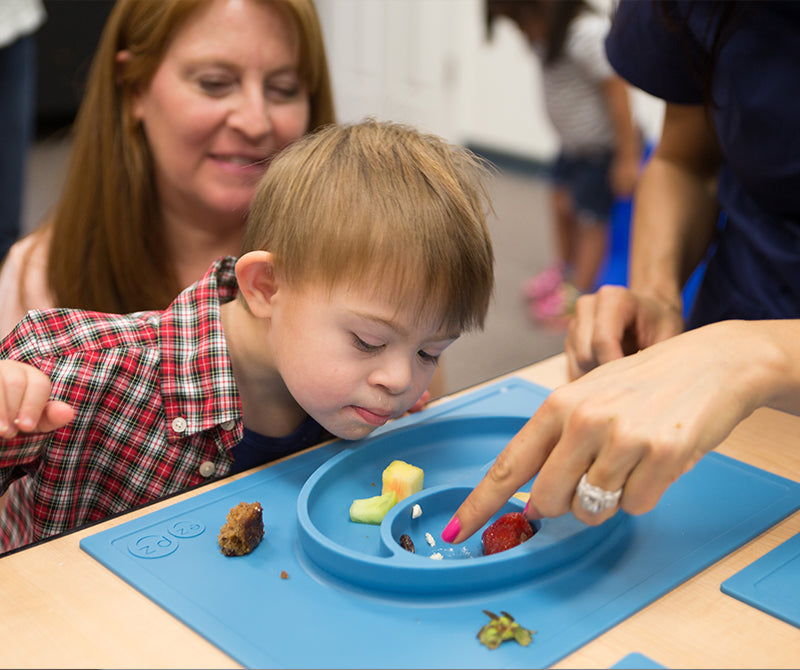I work with a lot of parents on how to feed their children and encourage picky eaters to eat, and I hear about the internal struggle of wanting your kid to be “good eater.” Some parents feel the pressure to bribe or even force-feed their kids in order to deliver adequate nutrition. Others entice the kid(s) with dessert or threaten them with an earlier bedtime. With all of the inaccurate feeding advice out there, parents are often unsure of the best ways to support their kids when trying new foods. One feeding therapy technique I use is called ‘nudge, don’t judge’ (I have coined the name), and it is a great way to support hesitant eaters. I have used the nudging technique in feeding sessions with my clients for over 15 years, and I even had a cute button made for all of my conference attendees to help them remember this important strategy! Here are some examples on how to use the ‘nudge, don’t judge’ technique.
Nudge: Nudging is a feeding therapy technique that allows kids to make food choices that are encouraged (not demanded) by the parent or feeding therapist. When we ‘nudge’ we are gently drawing our child’s attention to a food that the parent would like the child to eventually eat (or at least learn about and hopefully take a tiny bite!). Common feeding therapy methods such as demanding, bribing, begging, blaming, ignoring, threatening or force-feeding are unfortunately used by some feeding therapists and taught to parents, too. The ‘nudge’ is a positive method that will teach your child about food and support them in trying new foods!
- Draw attention to a food, texture, or food experience by gently pointing to it or commenting on it in a calm way (e.g., “look how the syrup soaked into the waffle on one side, but dripped off the waffle on the other side”). The child can then decide if they want to try a bite of the moist part of the waffle or the dry part. It gives kids more information and understanding of their preferences about food. And it decreases the possibility of them saying, “no, I don’t like it” when introducing waffles for the first time.
- Make sure that you eat what you are offering the child to eat so your can ‘nudge’ about how it tastes, what it feels like and layer in any other positive comments about the food. In my experience, I have the most success when I’m not making eye contact with the child, but I’m talking while looking at the food on my plate (e.g.,“I like how the Jell-O melts in my mouth and turns into a red juice”). Immediately Johnny wants to see if Jell-O will melt in his mouth too!
Don’t Judge: When we are feeding children, it’s important to remember that children’s taste buds are developing just like the rest of their growing body. Our reactions, attention and behaviors during mealtime have a lot to do with their decisions about what foods they choose to eat and enjoy. That is why it’s so important to be supportive during mealtime and help children learn about these new emerging tastes and food experiences. When we nudge and the child complies with taking a bite, we don’t want to judge their reactions or their conclusions about the food. To iterate, if they take a bite and their reaction is a sour face, we should refrain from saying “oh, it’s not that bad” or “don’t make that face.” Instead, reply with something more optimistic, like “hey, that was a new taste for you!”
Language Use: The language we use at mealtime can encourage or discourage kids to try a bite. We talk about this is our book Making Mealtime ezpz and provide examples on how to use encouraging expressions to nudge kids to explore new foods. This also implies that we are not judging their personal conclusions about the food they just explored and tasted. We need to respect that their emerging taste buds are different than our mature ones. Statements like “you can’t say you don’t like it” or “you barely licked it, so how can you hate it?” can hurt a child’s willingness to try something new with you in the future. The language we use needs to be considerate and supportive (e.g., “I’m excited that you were willing to taste it!”). Remember, the goal of the nudge is to get your child’s attention to that food so that they will try it and be willing to try a new food with you again. If we accomplish that, then we start a positive momentum on trying new tastes, textures, food and eventually…entire meals!
What are some fun and gentle ways you nudge your toddler at mealtime? What language do you use to encourage your child during meals? #ezpzfun #feedingtherapy #MsDawnSLP



